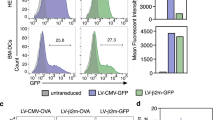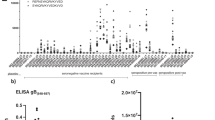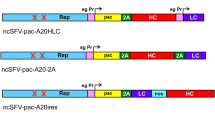Abstract
The successful development of adenovirus vectors for vaccines and gene therapy will require a better understanding of the host immune response. Using the ELISPOT assay to measure IFN-γ-secreting CD8+ cells, we identify immunodominant epitopes of the adenovirus hexon and DNA-binding protein in BALB/c and C57BL/6 mice. The T-cell response to the intramuscular administration of adenovirus serotype 5 peaks within a few weeks and gradually declines but is still detectable after 12 weeks. A second administration did not substantially increase the number of reactive T cells. The CD8+ T-cell response was also similar between wild type and E1-deleted adenovirus. When B-cell-deficient mice were injected with adenovirus encoding the gene for secreted alkaline phosphatase, sera phosphatase activity was reduced more quickly in mice pre-exposed to adenovirus. These results add to the evidence that cell-mediated immunity is a substantial barrier to therapeutic adenoviral vectors and provide more quantitative tools to measure cellular immune responses to adenovirus.
This is a preview of subscription content, access via your institution
Access options
Subscribe to this journal
Receive 12 print issues and online access
$259.00 per year
only $21.58 per issue
Buy this article
- Purchase on Springer Link
- Instant access to full article PDF
Prices may be subject to local taxes which are calculated during checkout




Similar content being viewed by others
References
Yang Y, Li Q, Ertl HCJ, Wilson JM . Cellular and humoral immune responses to viral antigens create barriers to lung-directed gene therapy with recombinant adenoviruses. J Virol 1995; 69: 2004–2015.
Yei S et al. Adenovirus-mediated gene transfer for cystic fibrosis: quantitative evaluation of repeated in vivo vector administration to the lung. Gene Therapy 1994; 1: 192–200.
Dai Y et al. Cellular and humoral immune responses to adenoviral vectors containing factor IX gene: tolerization of factor IX and vector antigens allows for long-term expression. Proc Natl Acad Sci USA 1995; 92: 1401–1405.
DeMatteo RP et al. Immunological barriers to hepatic adenoviral gene therapy for transplantation. Transplantation 1997; 63: 315–319.
Yang Y, Haecker S, Su Q, Wilson JM . Immunology of gene therapy with adenoviral vectors in mouse skeletal muscle. Hum Mol Gen 1996; 5: 1703–1712.
Tripathy SK, Black HB, Goldwasser E, Leiden JM . Immune responses to transgene-encoded proteins limit the stability of gene expression after injection of replication-defective adenovirus vectors. Nat Med 1996; 2: 545–550.
Gahery-Segard H et al. Immune response to recombinant capsid proteins of adenovirus in humans: antifiber and anti-penton base antibodies have a synergistic effect on neutralizing activity. J Virol 1998; 72: 2388–2397.
Chen P, Kovesdi I, Bruder JT . Effective repeat administration with adenovirus vectors to the muscle. Gene Therapy 2000; 7: 587–595.
Yang Y, Ertl HCJ, Wilson JM . MHC class I-restricted cytotoxic T-lymphocytes to viral antigens destroy hepatocytes in mice infected with E1-deleted recombinant adenoviruses. Immunity 1994; 1: 433–442.
Yang Y, Su Q, Wilson JM . Role of viral antigens in destructive cellular immune responses to adenovirus vector-transduced cells in mouse lungs. J Virol 1996; 70: 7209–7212.
Yang Y et al. Cellular immunity to viral antigens limits E1-deleted adenoviruses for gene therapy. Proc Natl Acad Sci USA 1994; 91: 4407–4411.
Kafri T et al. Cellular immune response to adenoviral vector infected cells does not require de novo viral gene expression: implications for gene therapy. Proc Natl Acad Sci USA 1998; 95: 11377–11382.
Jooss K, Ertl HCJ, Wilson J . Cytotoxic T-lymphocyte target proteins and their major histocampatibilty complex class I restriction in response to adenovirus vectors delivered to mouse liver. J Virol 1998; 72: 2945–2954.
Molinier-Frenkel V et al. Adenovirus hexon protein is a potent adjuvant for activation of a cellular immune response. J Virol 2002; 76: 127–135.
Olive M et al. The adenovirus capsid protein hexon contains a highly conserved human CD4+ T-cell epitope. Hum Gene Ther 2002; 13: 1167–1178.
Molinier-Frenkel V et al Immune response to recombinant adenovirus in humans: capsid proteins from viral input are targets for vector-specific cytotoxic T lymphocytes. J Virol 2000; 74 (16): 7678–7682.
Chirmule N et al. Role of E4 in eliciting CD4 T-cell and B-cell responses to adenovirus vectors delivered to murine and nonhuman primate lungs. J Virol 1998; 72: 6138–6145.
Lusky M et al. In vitro and in vivo biology of recombinant adenovirus vectors with E1, E1/E2A, or E1/E4 deleted. J Virol 1998; 72: 2022–2032.
Morsy M et al An adenoviral vector deleted for all viral coding sequences results in enhanced safety and extended expression of a leptin transgene. Appl Biol Sci 1998; 95: 7866–7871.
Ilan Y et al. Insertion of the adenoviral E3 region into a recombinant viral vector prevents antiviral humoral and cellular immune responses and permits long-term gene expression. Proc Natl Acad Sci USA 1997; 94: 2587–2592.
Mastrangeli A et al. Sero-switch adenovirus-mediated in vivo gene transfer: circumvention of anti-adenovirus humoral immune defenses against repeat adenovirus vector administration by changing the adenovirus serotype. Hum Gene Ther 1996; 7: 79–87.
Mack CA et al. Circumvention of anti-adenovirus neutralizing immunity by administration of an adenoviral vector of an alternate serotype. Hum Gene Ther 1997; 8: 99–109.
Qin L et al. Adenovirus-mediated gene transfer of viral interleukin-10 inhibits the immune response to both alloantigen and adenoviral antigen. Hum Gene Ther 1997; 8: 1365–1374.
Peng Y, Falck-Pedersen E, Elkon KB . Soluble CD8 attenuates cytotoxic T-cell responses against replication-defective adenovirus affording transprotection of transgene in vivo. J Immun 2000; 165: 1470–1478.
Jooss K, Yang Y, Wilson J . Cyclophosphamide diminishes inflammation and prolongs transgene expression following delivery of adenoviral vectors to mouse liver and lung. Hum Gene Ther 1996; 7: 1555–1566.
Fallaux FJ et al New helper cells and matched early region 1-deleted adenovirus vectors prevent generation of replication-competent adenoviruses. Hum Gene Ther 1998; 9: 1909–1917.
Berger J et al. Secreted placental alkaline phosphatase: a powerful new quantitative indicator of gene expression in eukaryotic cells. Gene 1988; 66: 1–10.
Chapman B, Thayer R, Vincent K, Haigwood N . Effect of intron A from human cytomegalovirus (Towne) immediate-early gene on heterologous expression in mammalian cells. Nucleic Acids Res 1991; 19: 3979–3986.
Klinman DM, Nutman TB . ELISPOT Assay to detect cytokine-secreting murine and human cells. In: Coligan JE et al (ed). Current Protocols in Immunology. John Wiley & Sons, Inc: New York, 1994; 1:pp 6.19.1–8.
Author information
Authors and Affiliations
Rights and permissions
About this article
Cite this article
McKelvey, T., Tang, A., Bett, A. et al. T-cell response to adenovirus hexon and DNA-binding protein in mice. Gene Ther 11, 791–796 (2004). https://doi.org/10.1038/sj.gt.3302232
Received:
Accepted:
Published:
Issue Date:
DOI: https://doi.org/10.1038/sj.gt.3302232
Keywords
This article is cited by
-
A recombinant virus-like particle vaccine against adenovirus-7 induces a potent humoral response
npj Vaccines (2023)
-
Mechanisms that allow vaccination against an oncolytic vesicular stomatitis virus-encoded transgene to enhance safety without abrogating oncolysis
Scientific Reports (2021)
-
Microbubble-mediated delivery of human adenoviruses does not elicit innate and adaptive immunity response in an immunocompetent mouse model of prostate cancer
Journal of Translational Medicine (2019)
-
Induction of complex immune responses and strong protection against retrovirus challenge by adenovirus-based immunization depends on the order of vaccine delivery
Retrovirology (2017)
-
Epitope-targeted cytotoxic T cells mediate lineage-specific antitumor efficacy induced by the cancer mucosa antigen GUCY2C
Cancer Immunology, Immunotherapy (2012)



